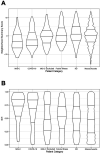Socioeconomic and Racial and/or Ethnic Disparities in Multisystem Inflammatory Syndrome
- PMID: 33602802
- PMCID: PMC8086000
- DOI: 10.1542/peds.2020-039933
Socioeconomic and Racial and/or Ethnic Disparities in Multisystem Inflammatory Syndrome
Abstract
Objectives: To characterize the socioeconomic and racial and/or ethnic disparities impacting the diagnosis and outcomes of multisystem inflammatory syndrome in children (MIS-C).
Methods: This multicenter retrospective case-control study was conducted at 3 academic centers from January 1 to September 1, 2020. Children with MIS-C were compared with 5 control groups: children with coronavirus disease 2019, children evaluated for MIS-C who did not meet case patient criteria, children hospitalized with febrile illness, children with Kawasaki disease, and children in Massachusetts based on US census data. Neighborhood socioeconomic status (SES) and social vulnerability index (SVI) were measured via a census-based scoring system. Multivariable logistic regression was used to examine associations between SES, SVI, race and ethnicity, and MIS-C diagnosis and clinical severity as outcomes.
Results: Among 43 patients with MIS-C, 19 (44%) were Hispanic, 11 (26%) were Black, and 12 (28%) were white; 22 (51%) were in the lowest quartile SES, and 23 (53%) were in the highest quartile SVI. SES and SVI were similar between patients with MIS-C and coronavirus disease 2019. In multivariable analysis, lowest SES quartile (odds ratio 2.2 [95% confidence interval 1.1-4.4]), highest SVI quartile (odds ratio 2.8 [95% confidence interval 1.5-5.1]), and racial and/or ethnic minority background were associated with MIS-C diagnosis. Neither SES, SVI, race, nor ethnicity were associated with disease severity.
Conclusions: Lower SES or higher SVI, Hispanic ethnicity, and Black race independently increased risk for MIS-C. Additional studies are required to target interventions to improve health equity for children.
Copyright © 2021 by the American Academy of Pediatrics.
Conflict of interest statement
POTENTIAL CONFLICT OF INTEREST: The authors have indicated they have no potential conflicts of interest to disclose.
Figures

Comment in
-
Author's Response.Pediatrics. 2021 Nov;148(5):e2021053907B. doi: 10.1542/peds.2021-053907B. Epub 2021 Oct 29. Pediatrics. 2021. PMID: 34716220 No abstract available.
-
RE: Racial and Ethnic Disparities in Multisystem Inflammatory Syndrome in Children.Pediatrics. 2021 Nov;148(5):e2021053907A. doi: 10.1542/peds.2021-053907A. Epub 2021 Oct 29. Pediatrics. 2021. PMID: 34716221 No abstract available.
References
-
- Castagnoli R, Votto M, Licari A, et al. . Severe acute respiratory syndrome coronavirus 2 (SARS-CoV-2) infection in children and adolescents: a systematic review. JAMA Pediatr. 2020;174(9):882–889 - PubMed
-
- Centers for Disease Control and Prevention. Health department-reported cases of multisystem inflammatory syndrome in children (MIS-C) in the United States. Available at: https://www.cdc.gov/mis-c/cases/index.html. Accessed January 28, 2021
-
- Belhadjer Z, Méot M, Bajolle F, et al. . Acute heart failure in multisystem inflammatory syndrome in children (MIS-C) in the context of global SARS-CoV-2 pandemic. Circulation. 2020;142(5):429–436 - PubMed
Publication types
MeSH terms
Supplementary concepts
Grants and funding
LinkOut - more resources
Full Text Sources
Other Literature Sources
Medical

